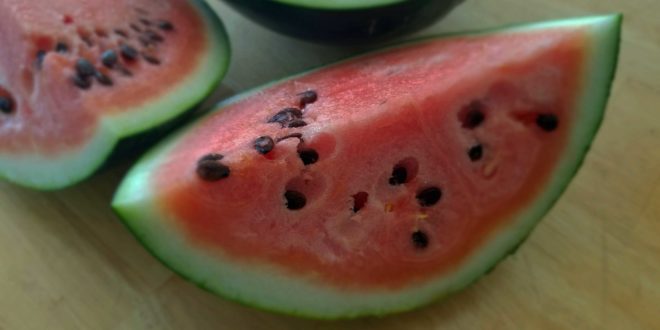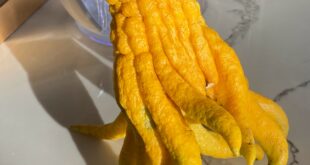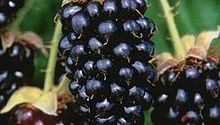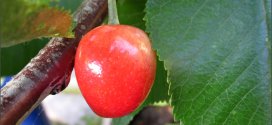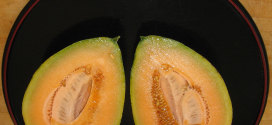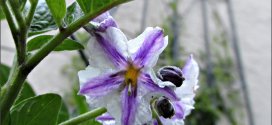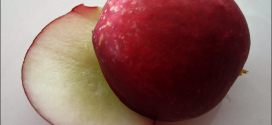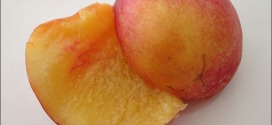New for 2019 in our Sunnyvale garden: Sugar Baby melons. They are round “picnic” or “icebox” watermelons perfect for small families and as the name suggests, small enough to fit into the icebox. They weigh in at between 7 to 10 pounds and are 7-8 inches across. They have either a dark green with slight dark veins or medium green with dark veined rind. The flesh is as mentioned, sweet, red, firm, and crisp with mottled with small, tan-black seeds.
As the name implies, Sugar Baby watermelons are one of the sweetest watermelon cultivars. Commercial watermelon growers value melons high in sugar and the name for this sweetness is called “brix” and can be scientifically measured. Sugar Baby watermelons have a brix measurement of 10.2. Citrullus lanatus, or Sugar Baby watermelon, is an incredibly productive grower as well.
Sugar Baby Cultivation
Sugar Baby melons, like all watermelons, require warm, dry temperatures to thrive. This early watermelon cultivar was first introduced in 1956 and is an early maturing variety, maturing in 75-80 days. They do best in Mediterranean climates where the vines spread out 12 feet or longer, with each plant producing two or three melons.
Most people start this melon via seed indoors at least six to eight weeks before outdoor planting time. It is recommended to plant 2 to 3 plants together for better pollination. These melons need rich, well-draining soil, amended with compost and manure. Ideally plant them in the ground rather than containers. Plant them in an area with at least eight hours of sun exposure per day and ideally at least 60 square feet of space per plant.
That being said, if you are familiar with our Sunnyvale garden, you know we do not have much open ground so I planted the Sugar Baby melons along with 7 other types of melon in the 4×6 former hot tub where the apricot tree grows. I planted them May 11. This did not interfere with the apricot harvest at the end of June.
Additional Information
Sugar Baby watermelon care requires consistent irrigation. Drip irrigation is recommended, as Sugar Baby varieties, like all watermelons, are susceptible to a variety of fungal diseases. Crop rotation and fungicide applications can also reduce the risk of potentially deadly disease.
These melons may also become infested with striped cucumber beetle which can be controlled through hand picking, rotenone applications, or floating row covers installed at planting. Aphids and nematodes, as well as diseases such as anthracnose, gummy stem blight and powdery mildew may all afflict the watermelon crop.
Melons are pollinated by bees. The plants have both yellow male and female flowers. Bees transfer pollen from male blooms to female blooms, resulting in pollination and fruit set. On occasion, the plants do not get pollinated, usually due to wet weather conditions or insufficient bee populations. You may need to give nature a hand, by hand pollinating the melons to increase productivity. Simply dab the male flowers gently with a small paintbrush or cotton swab and transfer the pollen to the female blooms.
When to Harvest
Watermelons do not continue to ripen once they are harvested .And it is difficult to know when to harvest. So here are some tips on when to harvest.
Tip #1: Find the Field Spot
If you don’t even read the other tips, this is the biggest indicator of a good watermelon. The field spot is a creamy spot on the outside, and it’s where the watermelon was resting on the ground. The field spot should be a yellowish creamy color. The more dark yellow the field spot is, the longer it was on the vine sweetening up. If the field spot is white (or not even there), this indicates an underripe melon.
Tip #2: Pick a Dull Looking Watermelon
A shiny appearance indicates an underripe melon. This applies to honeydew melons too.
Tip #3: Knock on It with Your Knuckles
Your knuckles should bounce off the melon, and the surface should be pretty hard/firm. You will get a dull thud if the flesh is soft, which indicates it is starting to spoil.
Tip #4: Get the Heaviest One for Its Size
This tip is only useful at the grocery store.
Tip #5: Check for a Uniform Shape
Some watermelons are round, some are oval, and either is fine. But if there are irregular bumps, this indicates the melon may have gotten inconsistent amounts of sun or water.
Tip #6: Look for the Sugar Spots and Pollination Points
If you see black spots on the melon (as pictured above), this is where sugar is seeping out and indicates a sweet melon. Also, if you see dots in a line (not a scratch), these are pollination points, and the more of them the better. I’ve been looking for these every time I pick up a melon and have had great luck with it in addition to the other tips.
